| << Chapter < Page | Chapter >> Page > |
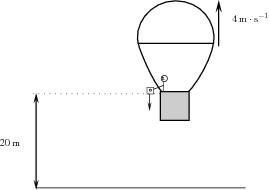
Vertical projectile motion is the same as motion at constant acceleration. In Grade 10 you learned about the graphs for motion at constant acceleration. The graphs for vertical projectile motion are therefore identical to the graphs for motion under constant acceleration.
When we draw the graphs for vertical projectile motion, we consider two main situations: an object moving upwards and an object moving downwards.
If we take the upwards direction as positive then for an object moving upwards we get the graphs shown in [link] .
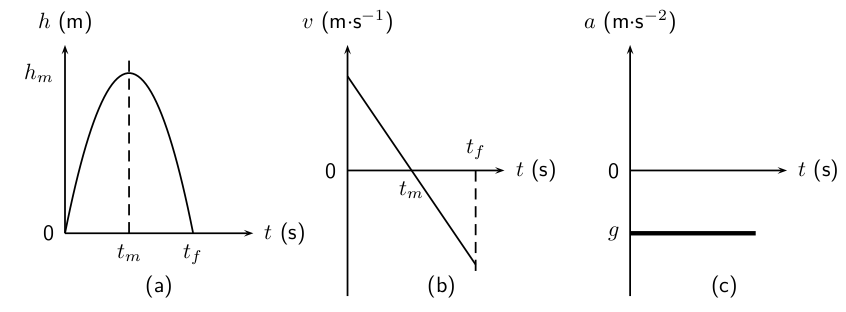
Stanley is standing on the a balcony 20 m above the ground. Stanley tosses up a rubber ball with an initial velocity of 4,9 m s . The ball travels upwards and then falls to the ground. Draw graphs of position vs. time, velocity vs. time and acceleration vs. time. Choose upwards as the positive direction.
We are required to draw graphs of
There are two parts to the motion of the ball:
We examine each of these parts separately. To be able to draw the graphs, we need to determine the time taken and displacement for each of the motions.
For the first part of the motion we have:
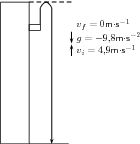
Therefore we can use to solve for the height and to solve for the time.
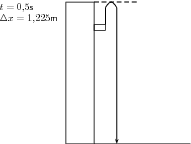
For the second part of the motion we have:
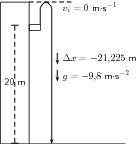
The ball starts from a position of 20 m (at t = 0 s) from the ground and moves upwards until it reaches (20 + 1,225) m (at t = 0,5 s). It then falls back to 20 m (at t = 0,5 + 0,5 = 1,0 s) and then falls to the ground, x = 0 m at (t = 0,5 + 2,08 = 2,58 s).
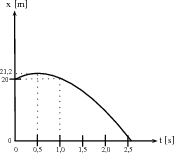
The ball starts off with a velocity of +4,9 m s at t = 0 s, it then reaches a velocity of 0 m s at t = 0,5 s. It stops and falls back to the Earth. At t = 1,0s (i.e. after a further 0,5s) it has a velocity of -4,9 m s . This is the same as the initial upwards velocity but it is downwards. It carries on at constant acceleration until t = 2,58 s. In other words, the velocity graph will be a straight line. The final velocity of the ball can be calculated as follows:
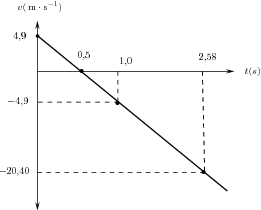
We chose upwards to be positive. The acceleration of the ball is downward. . Because the acceleration is constant throughout the motion, the graph looks like this:
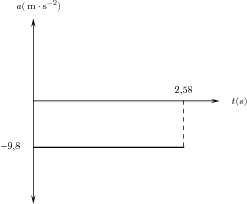
The graph below (not drawn to scale) shows the motion of tennis ball that was thrown vertically upwards from an open window some distance from the ground. It takes the ball 0,2 s to reach its highest point before falling back to the ground. Study the graph given and calculate
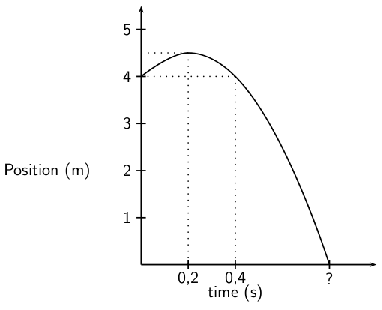
The initial position of the ball will tell us how high the window is. From the y-axis on the graph we can see that the ball is 4 m from the ground.
The window is therefore 4 m above the ground.
The maximum height is where the position-time graph show the maximum position - the top of the curve. This is when t = 0,2 s.
It takes the ball 0,2s to reach the maximum height.
To find the initial velocity we only look at the first part of the motion of the ball. That is from when the ball is released until it reaches its maximum height. We have the following for this: In this case, let's choose upwards as positive.
To calculate the initial velocity of the ball ( ), we use:
The initial velocity of the ball is 1,96 m s upwards.
To find the maximum height we look at the initial motion of the ball. We have the following:
To calculate the displacement from the window to the maximum height ( ) we use:
The maximum height of the ball is (4 + 0,196) = 4,196 m above the ground.
To find the final velocity of the ball we look at the second part of the motion. For this we have:
We can use to calculate the final velocity of the ball.
The final velocity of the ball is 9,07 m s downwards .
A cricket ball is hit by a cricketer and the following graph of velocity vs. time was drawn:
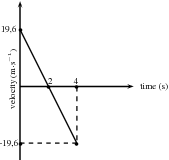
A cricketer hits a cricket ball from the ground and the following graph of velocity vs. time was drawn. Upwards was taken as positive. Study the graph and follow the instructions below:
We need to study the velocity-time graph to answer this question. We will break the motion of the ball up into two time zones: t = 0 s to t = 2 s and t = 2 s to t = 4 s.
From t = 0 s to t = 2 s the following happens:
The ball starts to move at an initial velocity of 19,6 m s and decreases its velocity to 0 m s at t = 2 s. At t = 2 s the velocity of the ball is 0 m s and therefore it stops.
From t = 2 s to t = 4 s the following happens:
The ball moves from a velocity of 0 m s to 19,6 m s in the opposite direction to the original motion.
If we assume that the ball is hit straight up in the air (and we take upwards as positive), it reaches its maximum height at t = 2 s, stops, turns around and falls back to the Earth to reach the ground at t = 4 s.
To draw this graph, we need to determine the displacements at t = 2 s and t = 4 s.
At t = 2 s:
The displacement is equal to the area under the graph:
Area under graph = Area of triangle
Area = bh
Area = 2 19,6
Displacement = 19,6 m
At t = 4 s:
The displacement is equal to the area under the whole graph (top and bottom). Remember that an area under the time line must be substracted:
Area under graph = Area of triangle 1 + Area of triangle 2
Area = bh + bh
Area = ( 2 19,6) + ( 2 (-19,6))
Area = 19,6 - 19,6
Displacement = 0 m
The displacement-time graph for motion at constant acceleration is a curve. The graph will look like this:

To draw the acceleration vs. time graph, we need to know what the acceleration is. The velocity-time graph is a straight line which means that the acceleration is constant. The gradient of the line will give the acceleration.
The line has a negative slope (goes down towards the left) which means that the acceleration has a negative value.
Calculate the gradient of the line:
gradient =
gradient =
gradient =
gradient = -9,8
acceleration = 9,8 m s downwards

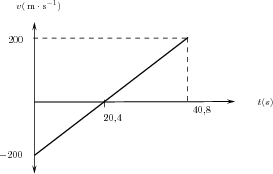

Notification Switch
Would you like to follow the 'Siyavula textbooks: grade 12 physical science' conversation and receive update notifications?